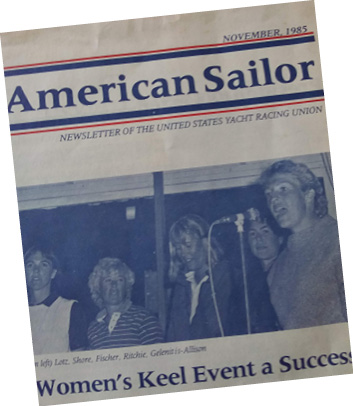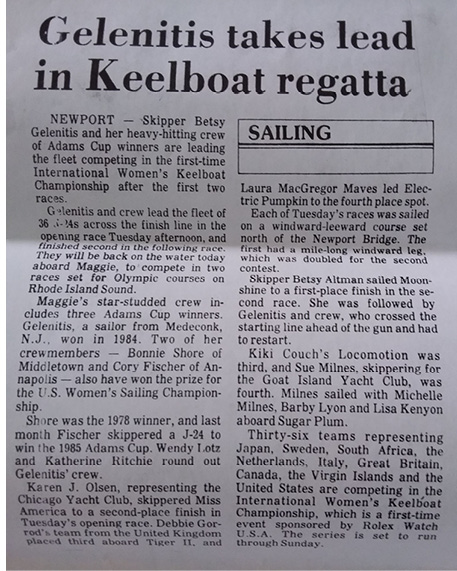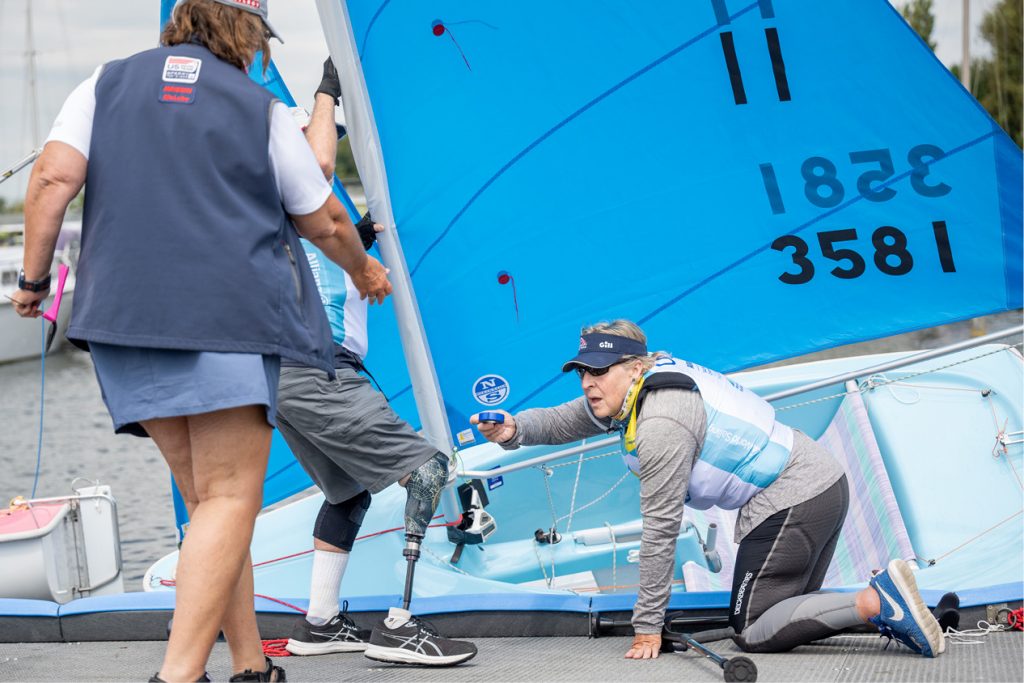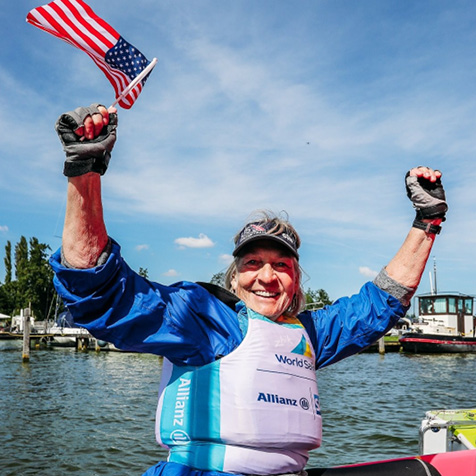Betsy Alison and 38 Years in Modern Women’s Sailing
By Tom Darling, Conversations with Classic Boats
In last month’s WindCheck, we interviewed our old friend and Princeton classmate Marilee Allan. From a Southern California sailing family, Marilee anchored the team that won the 1974 Women’s Intercollegiate Championship and went on to win them through 1977. She was a pioneer who along with her Newport Beach neighbor, the late Nina Nielsen, were the first female inductees into the Intercollegiate Hall of Fame, in 1995.
Betsy Alison, 1985 and 2023

Winners of the inaugural Rolex Women’s International Keelboat Championship, Team Softsail graces the cover of American Sailor in November 1985. From left to right are Wendy Darling Lotz, Bonnie Shore, Cory Sertl Fischer, Kathryn
A decade after women’s sailing broke out at the college level, a Tufts graduate from Metedeconk River on Barnegat Bay, a Lightning ace, set out with her crew to win a world championship in perhaps the first truly international women’s regatta. She was Betsy Gelenitis Alison. That event was the Rolex International Women’s Keelboat Championship (IWKC). With teammates Cory Sertl Fischer, Kathryn Ritchie Josenhans, Bonnie Shore and my younger sister Wendy Darling Lotz, the crew of the J/24 Maggie sailed out of Newport, Rhode Island with Hurricane Gloria looking over their collective shoulder. They won what became known as “The Women’s Worlds.” Betsy, a five-time Rolex Yachtswoman of the Year, would win this event another four more times.
Thirty-eight years on, having coached the US Paralympic Sailing squad for a quarter century and having survived a harrowing bout with cancer, Betsy would triumph in a very different way. In August 2023, she stepped to the top of the podium at the Sailing World Championships in the Hague, the Netherlands to accept the gold medal for winning the Para Sailing Singlehanded Championship.

This newspaper story reported “Betsy and her heavy-hitting crew of Adams Cup winners are leading the fleet.”
These are two inspiring stories. This telling of the first was the result of a Zoom meeting we organized in August 2023 for the 1985 “Team Softsail,” so named for their sponsor, a popular household cleaner. To the best of their knowledge, “The Five” had never gathered in one place since the 1985 Rolex IWKC. They were ready to reminisce about what was the first of an iconic event in women’s sailing, which is still held every two years. (The transcripts have been edited for brevity and clarity.)
The Rolex International Women’s Keelboat Championship
In 1985, the stage was set for the first truly international women’s open racing event. It was called “Rolex” because its title sponsor has a history with high-profile sailing events; “International” because nine of the three dozen teams hailed from outside the U.S., with Japan the long-distance champion; “Keelboat” because the weapon of choice for this shootout was the J/24. Ironically, the J/24 had been skippered by virtually no women but they were common after eight years of production and easy to procure from current owners.
The discussion between the five crew members comprises memories of hundreds of years of women’s sailing experience. As with so many pioneers, Team Softsail was both self-effacing and a bit incredulous about the events of that fall. They seemed thrilled to reunite, wondering why it had taken so long.
The Lightning Connection
There were a few common elements among their backgrounds. All had sailed at a top competitive level in the Lightning class. Only one had done serious intercollegiate sailing – Betsy Alison, who was coached at Tufts by the legendary Joe Duplin. Three were intimately knowledgeable with the venue and the tricky winds and currents of the Newport racecourses. That experience, and the teamwork forged in a very short time before the regatta, carried them to the podium. But in many ways they were a Women’s Sailing Dream Team, like the 1992 Barcelona Olympics Men’s Basketball Team. They were married, unmarried, and about to be married. They gelled on the spot. And they won.
The conditions were daunting. The skipper, who had never driven a J/24, enlisted guidance from one Kenny Read, Rhode Island rockstar and reigning World Champion in the class. The regatta was interrupted by Hurricane Gloria, which forced the teams to sequester their boats in the Revolutionary War vintage stone fortress of Fort Adams and sit out the storm with no power. Their leader was Betsy. She spoke about the experience spoke positively, enthusiastically and forcefully.
“This was the team that came together, and I don’t know who planted the seed. I think Cory reached out to me and said, ‘all these Lightning sailors are coming together to sail a J/24 in this big new regatta’ and did I want to drive? I was 25 years old and I said, ‘Sure, that would be great.’ Internally, I was terrified because I had never sailed a keelboat, but we all had been racing Lightnings.”
The rest of the 1985 crew (including three Adams Cup winners), from the back of the boat forward was:
Cory Sertl Fischer, trim and tactics – A local schooled as a sailing instructor in Jamestown, across Narragansett Bay from Newport, she’s a Lightning legend.
Bonnie Shore, spinnaker trimmer – A Newport sailmaker from the family of Shore Lightning sailors, she brought the boat Maggie and big race experience.
Kathryn Ritchie Josenhans, pit – Hailing from Connecticut, she was front crew for Lightning ace Ched Procter.
Wendy Darling Lotz, foredeck – a Newport resident, she’s my younger sister and junior Blue Jay and hotshot Lightning crew.
How did this new team learn the J/24? From the Jedi Master of J/24 himself, Kenny Read, kingpin of the Rhode Island Sailing Mafia. Betsy described the team’s learning process, from tuning the rigging to figuring out how to drive and grind the windward jibsheet at the same time.
“I had no J/24 experience, and when the team came to me I said, ‘Who better to consult than Ken Read, the then reigning World Champion?’ Kenny and I met at Handy Lunch in Newport and I said, ‘I need you to tell me how this works and who does what.’ On a small piece of paper, Kenny drew a picture of the boat and where people go. He added, ‘By the way, you have to carry the winch handle across the boat and grind those last few inches.’”
“We all met at the boat for the first time and I said, ‘This is what I know’ and started spouting what Kenny had told me. Our personalities gelled really well. I was worried going into the practice race, and had nightmares the night before. We hadn’t had any practice. I had to learn as quickly as I could.”

Betsy has guided numerous athletes to success in Para Sailing, especially at the Olympic level.
Color on Team Softsail
As co-tactician and mistress of spinnaker trimming, Bonnie Shore was from the Shore Clan that has been a force in Lightnings and around Newport seemingly forever. Beaming in from her house in Florida, Bonnie was the Mother Hen of Team Softsail, and the senior member of the crew there was not much she hadn’t seen. She’d learned it from Bill and Doug Shore during a long run at high levels of Lightning sailing.
“Sail. sail, sail was my life,” Bonnie recalls. “My father had a Lightning, and I did nothing but sail and race and that was my life. I just happened to have a J/24, wouldn’t you know, and donated it to the cause. Betsy got us good sponsors and we could really work and make it a great boat. If I got Betsy as a helmsman I was in heaven, and I know from day one we were going to win the regatta.”
Cory qualified as the local knowledge. She grew up sailing across from Newport in Jamestown at Conanicut Yacht Club, and was a student of the fickle currents and variable winds of Newport. “My connection was summers in Rhode Island when I sailed with Bill and Bonnie, and they got me into the Lightning class.”
Kathryn Ritchie bridged the cockpit and foredeck, labelled the pit. From Dalouisie University in Nova Scotia, she had years of experience on the bow for Lighting ace Ched Procter in Fairfield County.
When I think of the Rolex Women’s Worlds I think of my sister Wendy Darling Lotz, the only family member with the Peter Pan legacy name. She grew up on Narraganset Bay as a long-suffering crew on my Blue Jay #2662 Chock Full of Nuts. A familiar sight on the bow of race boats up to J/30s, she was the consulting detective of the foredeck – unflappable. “It’s all about timing and teamwork,” she explained. “If the skipper is driving well, my job is easy.”
Truth be told, the family affair extended very discretely to the event’s Race Committee. My parents, Wells and Mary Will (now 95 and 93, respectively) had moved to Newport in 1984 and were about to join Ida Lewis Yacht Club, on Lime Rock in Newport Harbor. The IWKC chair, Ann Connor, had asked my father to be serve on the Race Committee, a pretty big job for a new arrival. My mother came on as majordomo of signals and shapes. She whispered to me recently that men might not be trusted to keep all the housekeeping straight.
The Practice Race and Gloria’s Visit
I was always told that winning the practice race was bad karma, but this practice race was a leading indicator. Team Softsail won, and never doubted that they would…not a hitch…
Except for the complication of one small detail, a hurricane named Gloria. In 1985, the tracking of hurricanes was not part of the sailor’s vocabulary. I had experienced hurricanes in 1960 and ’65, but no one had the playbook for dealing with thirty-six borrowed keelboats.
The decision was wisely made to evacuate the boats, but to where? Easy – you pluck them out of Brenton Cove, then roll them on trailers into Fort Adams, 1790’s answer to warding off foreign naval invasion. Would it accommodate all three dozen J/24s? Absolutely, like children’s toys with masts peeking over the 18th century battlements.
The morning after, power gone, from the cupola in my parents’ Newport house you could see the fleet looking like escapees from a Pirates of the Caribbean movie, ready for a ghostly sail out of the fort. But the following day, the storm was gone, the water was high and the power was still off. No hoists would mean no boats in the water and no racing. The solution, from a local yacht club member, was already in place. A huge yellow mechanical wheeled device was waiting to pick up the J/24s and deposit them over the berm into the water. Problem solved, the regatta recommenced.
Team Softsail, their white spinnaker emblazoned with a retro logo of a woman wielding cleaning supplies, quickly and efficiently finished what they started. They won. The team picture was right out of the ‘80s: low resolution, no social media links. But thanks to Kathryn’s mother, Mrs. Ritchie back in Nova Scotia, the press clippings confirm the story of Team Softsail. Cory summed it up, “We made so many friends. It’s a sport where we continue to compete in so many ways.” International women’s sailing had arrived. Three years later, Women’s Sailing debuted in the 1988 Pusan Olympics.

A champion, always
The Rough Road to Gold, 2023
After twenty-five years of coaching the most successful US Paralympic Sailing Team of all time, disaster struck Betsy Alison. The following is excerpted from the Olympics.com
Website:
In November of 2022, a team of surgeons at Massachusetts General Hospital removed a cancerous tumor the size of a football from Alison’s hip, subsequently removing 90% of her glute muscles, part of her femur, half of her pelvis and reconfiguring much of her hip and upper leg muscles.
“I had no idea whether I was going to come out with a leg,” said Betsy. Nine months later, she stepped to the top of the podium at the 2023 Sailing World Championships…with a gold medal.
After relearning to walk in the early months of 2023, the Sailing World Championships came into view for the decorated sailor. Held in August, it marked the first test for a recovering champion. Her goals were:
1) Use the championship as a clear-cut date to finish weaning off prescription drugs;
2) Successfully travel alone.
There was nothing on the list about winning. Maybe that was assumed.
After a three-day training trip to Sacramento, Betsy had traveled across the country on her own and trained in the Hansa 303, the boat she would be racing for the first time in the Hague. This both boosted her confidence and prepared her for her first race in more than eighteen months.
The result? She took the world by storm in a 10-day battle with Poland’s Olga Gormus-Grudzen, leaving her mark with the gold and a world title in a boat she had only just learned to sail.
“I felt that I had already won before I got into a boat,” she said. “Honestly, this was a bonus on top of everything else. It just felt great to be back in a boat again.”
The headline in 1985 read: U.S. crew atop the international women’s sailing podium
The headline in 2023 was: Women’s sailing ace blazes tough path to gold, again.
Looking back at her many successes, Betsy says her strategy has always been, “Find the best and keep asking questions.
It’s not one award. It’s not one event. It’s the collective history of what I’ve been able to achieve.” ■
Thanks to Olympics.org and the entire 1985 Team Softsail, wherever you are.
Not a formally trained historian nevertheless a boat storyteller, collecting and reciting stories for the boating curious, Tom Darling is the host of Conversations with Classic Boats, “the podcast that talks to boats.” Tune in via Apple Podcast, Google Podcast or Spotify, or online at conversationswithclassicboats.com.
